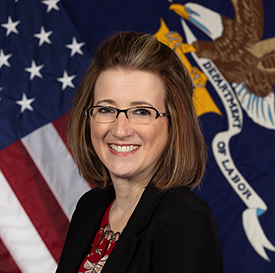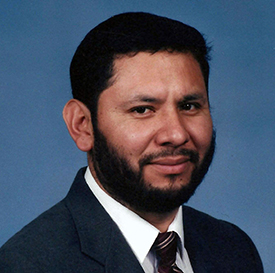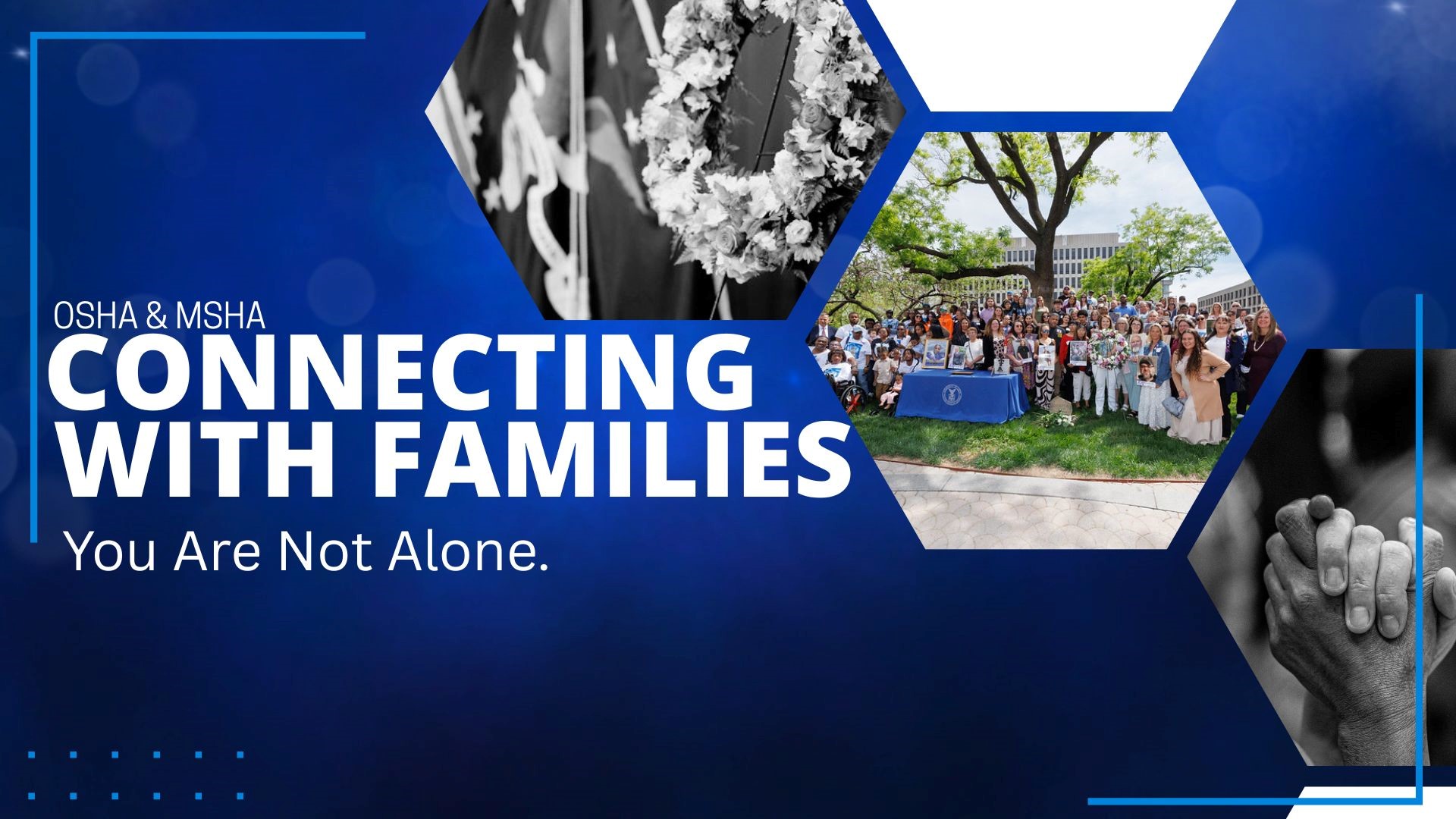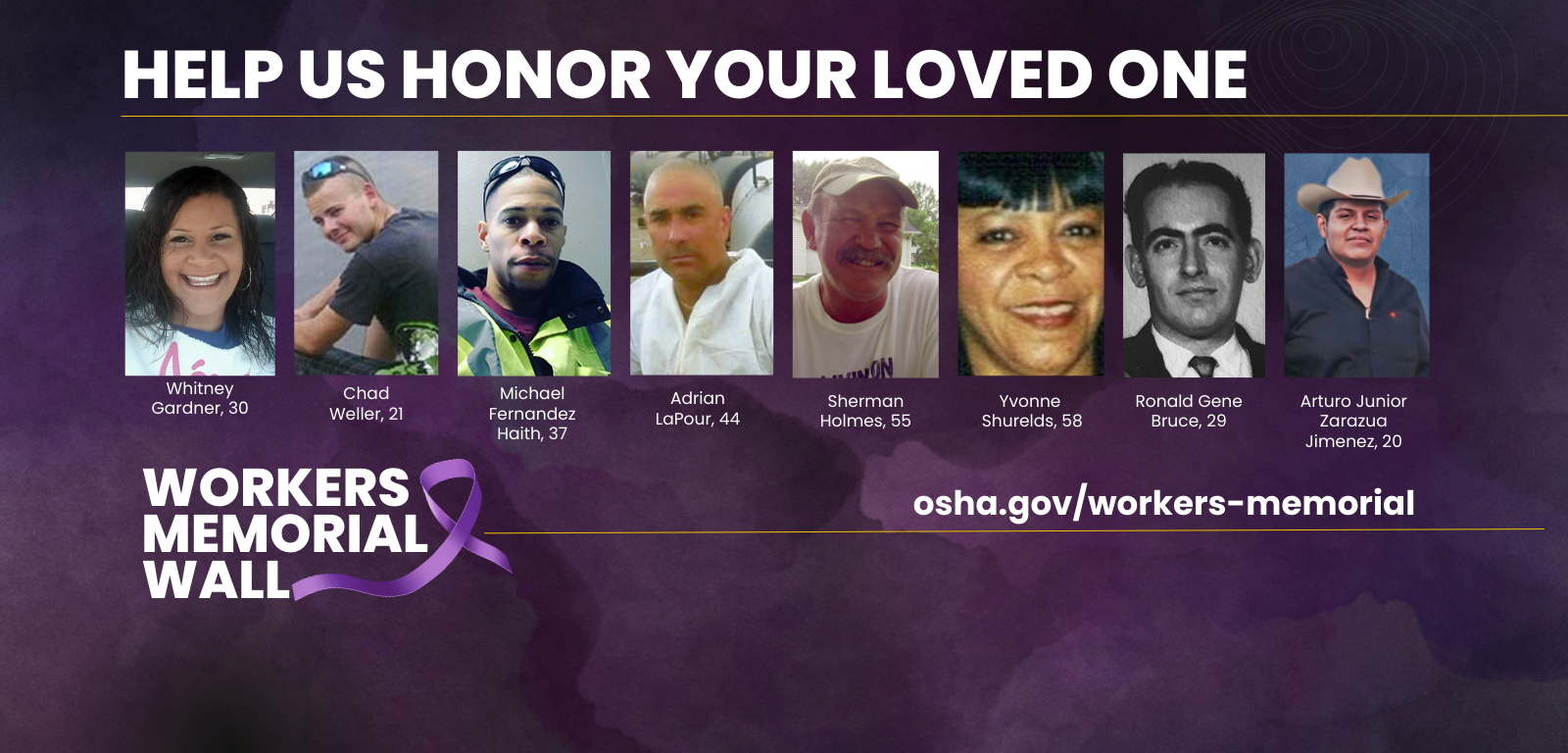Our Condolences
A Message to the Families of Our Fallen Workers.

Please accept my sincere condolences on your loss.
Your loss is immense, and there is no other loss that compares to your family's loss.
At a time in which you are remembering, honoring, recognizing, and mourning your loved one, you may be overwhelmed with many questions and concerns.
I too lost someone dear to me in a work incident in 2009 and although I will never compare my loss to yours, please know that I understand the overwhelming emotions and questions you may have. For nearly 16 years I have been honored to connect with parents, spouses, children, and many others affected by a variety of occupational incidents offering them guidance, resources and support in their time of need. Please know that you and your family are not alone during this time.
Below you will find information and resources that I hope you will find helpful. I also invite you to contact me at a time that is convenient for you as I hope to ease some of your concerns by assisting you in finding the answers to the questions you may have in regard to your loss.
Please do not hesitate to reach out, especially during this difficult time, as I am here for you. Again, I want to express my deepest sympathy to you and your family as my heart goes out to you at this difficult time.
Sincerely,
Tonya Ford
Family Liaison
USDOL/OSHA
ford.tonya.e@dol.gov
(531) 893-3409
In Remembrance
 Joe McDonald, 75
Joe McDonald, 75
Kentucky
 Brooke Baures, 21
Brooke Baures, 21
Wisconsin
 Gerald (Jerry) Kennedy, 30
Gerald (Jerry) Kennedy, 30
Minnesota
 Jose Luis Jacobo, 39
Jose Luis Jacobo, 39
Iowa
OSHA has created a Workers Memorial Wall to honor and recognize all of those who lost their life due to an occupational injury, illness, or disease.
If you have lost a loved one due to a work-related incident last year or 50 years ago, we invite you to share their photograph with OSHA at remembrance@dol.gov as we will recognize them on our virtual Workers Memorial Tribute Wall.
Upcoming Events

Monday, December 15, 2025, at 7:00 p.m. ET (6:00 p.m. CT)
This December the Occupational Safety and Health Administration (OSHA) invites family members/loved ones of our fallen worker from across the U.S. to join us at our "Connecting with Families" meeting to discuss how to cope with loss during the holiday season.
We understand that it may be difficult to connect with others that know what it is like to lose a loved one in a work-related incident. Please know you are not alone. We are hosting our upcoming meeting in hopes that you may gain and continue a connection with others that have also been directly affected by such a loss.
Please know out of respect of you and all our family members this meeting is private and only open to family members/loved ones of our fallen workers. We hope that you can join us and begin connecting with others for additional support and guidance in your time of need.
Save the date as registration is opening soon!
Family Resources
Available in multiple languages.
Support Groups
Construction Angels: www.constructionangels.us
National COSH: www.nationalcosh.org
Suicide and Crisis Lifeline: Call 988
United Support & Memorial For Workplace Fatalities (USMWF): www.usmwf.org
OSHA Establishment Search
Use OSHA's Establishment search to search for OSHA enforcement inspections by the name of the Establishment.
Use OSHA's inspection information search to search for an inspection by the inspection number.
Other Agencies
Wage and Hour: (866) 487-9243
Office of Whistleblowers: (202)551-4790
Department of Justice: (202) 514-2000
Facts and Questions
With the Occupational Safety and Health Act of 1970, Congress created the Occupational Safety and Health Administration (OSHA) to ensure safe and healthful working conditions for workers by setting and enforcing standards and by providing training, outreach, education and assistance.
OSHA is part of the United States Department of Labor. The administrator for OSHA is the Assistant Secretary of Labor for Occupational Safety and Health. OSHA's administrator reports to the Secretary of Labor, who is a member of the cabinet of the President of the United States. OSHA is divided up into 10 Regions and within those regions are Area Offices that will report to the Regional Administrators. We have approximately 100 federal offices across the country.
OSHA covers most private sector employers and workers in all 50 states, the District of Columbia, and the other United States (U.S.) jurisdictions – either directly through OSHA or through an OSHA-approved State Plan.
Workers at state and local government agencies are not covered by Federal OSHA but have OSH Act protections if they work in states that have a State Plan.
Select the links to verify if you are covered by our approved State Plan or Federal OSHA.
For more information go to About OSHA | Occupational Safety and Health Administration.
OSHA Directory
Public sector employees are employed by state and local government, private sector employees are employed by privately-owned companies.
OSHA only investigates work-related fatalities that fall under OSHA's jurisdiction. OSHA may not have the authority to investigate fatalities due to lack of coverage, or exemptions provided by Congressional Acts. For example, if a fatality occurs at a workplace that is exempt under the Appropriations Act, OSHA is unable to investigate the fatality.
OSHA's onsite inspection process begins with the presentation of the compliance safety and health officer (CSHO) credentials. The inspection process is a three-step process:
- The opening conference;
- Walkaround; and
- The closing conference.
During the opening conference, the CSHO will:
- Explain the reason for inspection, scope of the inspection, walkaround procedures, employee representation, and employee interviews.
- Review worksite injury/illness records and certain written safety and health policies, and check to see that the OSHA poster is displayed in a noticeable location, to ensure employees are advised of their rights.
- Identify employer and employee representatives to accompany the compliance officer during the inspection (Note that authorized representatives of employees have a right to accompany CSHOs during all aspects of an inspection);
Following the opening conference, the CSHO and the representatives will conduct a walkaround of the workplace which will include:
- Observations, pictures and/or video of areas where the fatal injury occurred to determine what safety and/or health hazards may have existed during the time of the fatal injury.
- Private interviews with a reasonable number of employees to gather factual information relevant to a safety and health inspection.
- Measurements of air contaminants, noise and/or other conditions where relevant to the scope of the inspection.
The walkaround phase of the inspection may occur over multiple days.
- After the walkaround, the CSHO will hold a closing conference with the employer and the employee representative(s) and discuss potential safety and/or health violations and ways to correct hazards; deadline requirements of potential citations; and possible fines.
-
Possible courses of action the employer may take following an
inspection which could include:
- an informal conference with OSHA; or
- contesting alleged citations and proposed penalties.
- Consultation services and employee rights following an OSHA inspection.
- Workers' rights to raise safety and health concerns without fear of retaliation. (www.osha.gov/workers)
OSHA may take up to six months from the date of the incident to complete the inspection and to issue citations and/or penalties.
If violations of OSHA standards were identified during the inspection, citations and/or penalties may be issued.
An employer may acknowledge the violations, agree to pay the proposed penalties, and certify that the hazard(s) has/have been corrected. At this point, the citations become final order. The employer pays the penalties, and the case is closed.
An employer may choose to meet with the Area Office for an informal conference and/or contest the citation and violation within 15 working days of receipt of the citations. The case may be settled at the informal conference. Citations may be amended, and penalties may be changed. Once all abatement and payments are received, the case is closed.
If the employer decides to contest part or all of the citation, penalty and/or abatement date, the case proceeds through an administrative review process, with the Occupational Safety and Health Review Commission (OSHRC). The OSHRC is an independent federal agency that is not part of the Department of Labor or OSHA. The employer or OSHA may further appeal the case in the appropriate United States Court of Appeals, if dissatisfied with the OSHRC's decision. Just like other court cases, this could take an extended amount of time.
OSHA may contact family members of employees involved in the fatality at an early point in the investigation and give the family an opportunity to discuss the circumstances of the incident. If another family member or friend has information or evidence that could assist in the inspection, they are encouraged to contact and share this information with the local OSHA Area Office overseeing the inspection.
No. OSHA investigates workplace fatalities to determine whether a violation of OSHA safety and health standards or the general duty clause of the OSH Act (Section 5(a)(1)) has occurred.
Employers must comply with the General Duty Clause of the OSH Act. This clause requires employers to keep their workplaces free of serious recognized hazards and is generally cited when no specific OSHA standard applies to the hazard.
The following elements are necessary to prove a violation of the General Duty Clause:
- The employer failed to keep the workplace free of a hazard to which employees of that employer were exposed;
- The hazard was recognized;
- The hazard was causing or was likely to cause death or serious physical harm; and
- There was a feasible and useful method to correct the hazard.
Violations are categorized as willful, serious, other-than-serious, de minimis, failure to abate, and repeated. If the workplace inspection finds no alleged violation(s), related to or not related to the incident, citations or proposed penalties may not be issued.
The following general information defines the types of violations:
- Willful: A willful violation exists under the OSH Act where an employer has demonstrated either an intentional disregard for the requirements of the OSH Act or a plain indifference to employee safety and health.
- Serious: Section 17(k) of the OSH Act provides that "a serious violation shall be deemed to exist in a place of employment if there is a substantial probability that death or serious physical harm could result from a condition which exists, or from one or more practices, means, methods, operations, or processes which have been adopted or are in use, in such place of employment unless the employer did not, and could not with the exercise of reasonable diligence, know of the presence of the violation." OSHA may propose a penalty for each violation.
- Other-Than-Serious: This type of violation is cited in situations where the accident/incident or illness that would be most likely to result from a hazardous condition would probably not cause death or serious physical harm but would have a direct and immediate relationship to the safety and health of employees. OSHA may impose a penalty for each violation.
- De Minimis: conditions are those where an employer has implemented a measure different from one specified in a standard, that has no direct or immediate relationship to safety or health. These conditions do not result in citations or penalties.
- Failure to Abate: A failure to abate violation exists when a previously cited hazardous condition, practice or non-complying equipment has not been brought into compliance since the prior inspection (i.e., the violation remains continuously uncorrected) and is discovered at a later inspection. If, however, the violation was corrected, but later reoccurs, the subsequent occurrence is a repeated violation. OSHA may impose a penalty for each violation.
- Repeated: An employer may be cited for a repeated violation if that employer has been cited previously, within the last five years, for the same or a substantially similar condition or hazard and the citation has become a final order of the Occupational Safety and Health Review Commission (OSHRC). A citation may become a final order by operation of law when an employer does not contest the citation, or pursuant to court decision or settlement. Repeated violations can bring a civil penalty.
For more information: https://www.osha.gov/sites/default/files/publications/osha3000.pdf
OSHA places a high priority on maintaining communication with family members after a workplace fatality. If family members have any questions about the investigation or any information that might be helpful, they should not hesitate to contact the area office conducting the inspection.
Additionally, we invite you to contact OSHA's Family Liaison, Tonya Ford at a time that is convenient for you. She is here to assist you in finding the answers to the questions you may have in regard to your loved one's incident, the inspection process, about Workers Memorial Day and/or OSHA.
She can be reached via email (ford.tonya.e@dol.gov) or phone 531-893-3409.
Please do not hesitate to reach out, especially during this difficult time.
Once the inspection is completed, the listed next-of-kin should be contacted by the area office and notified as to whether citations and penalties will be proposed. If citations and penalties are proposed, the next-of-kin should be provided with a copy.
Yes. An employer can contest any portion of a citation, including the violation, penalty amount, and abatement date.
The employer must submit the Notice of Intent to Contest in writing to the OSHA area office within 15 working days after receipt of the Citation and Notification of Penalty.
In some cases, OSHA may reduce proposed penalties. For example, if the company submits documentation that they promptly corrected the hazards OSHA identified, or if they committed to evaluating and implementing improvements at other company sites.
OSHA's primary concern remains prevention of injuries, illnesses, and deaths rather than collection of funds. The civil penalties under the OSH Act are not based on the occurrence of a fatality. OSHA understands no amount of money will equal the value of your loss.
When an employer willfully violates an OSHA standard and the alleged violation was the direct cause of, or a contributing factor to, an employee's death, OSHA may refer the case to the United States Department of Justice to seek criminal prosecution of the employer.
The Freedom of Information Act (FOIA) provides the public the right to request access to records from any federal agency.
If the employer is located in a state under federal OSHA jurisdiction, send an email to foiarequests@dol.gov, with the following information if you are seeking inspection records:
- Inspection number (find it here)
- City and state where incident occurred
- Date incident occurred
- Employer name that was inspected
- Your name (the requester) and your physical address.
If the employer is not under federal OSHA, send your request to the state plan.
If you have questions, contact OSHA at OSHA.FOIA@dol.gov.
For more information: https://www.osha.gov/foia
OSHA's policy is to disclose, to the extent possible, all documents in safety and health inspection files unless disclosure is prohibited by law or if disclosure would harm an interest protected by one of the statutory exemptions, please see exemptions in FOM-Chapter 16, Section III.
All agency records must be made available to the public under the Freedom of Information Act (FOIA), except for records that are:
- Properly classified as secret in the interest of national defense or foreign policy.
- Related solely to internal personnel rules and practices.
- Specifically exempted by other statutes.
- Concerning trade secrets and commercial or financial information obtained from a person that is privileged or confidential.
- Privileged interagency or intra-agency memoranda or letters, except under certain circumstances.
- Personnel and medical files and similar files, the disclosure of which would constitute a clearly unwarranted invasion of personal privacy.
- Investigatory records compiled for law enforcement purposes.
- Contained in or related to certain examination, operating, or condition reports concerning financial institutions.
- Geological and geophysical information and data, including maps, concerning wells.
For more information: https://www.dol.gov/general/foia/exemptions
The "Justice Department Guide to the Freedom of Information Act" provides more detail on these exemptions as well as FOIA law enforcement record exclusions and certain procedures.
Not for federal records. However, this policy may differ within state plans. The portions of the file that can be released under FOIA will be made available to the listed next-of-kin, at no charge, upon written request to OSHA.
Workers Compensation
https://labor.alabama.gov/wc/workers-compensation.aspx
https://portal.ct.gov/DAS/Services/For-State-Employees/Workers-Compensation
https://labor.delaware.gov/divisions/industrial-affairs/workers-comp/



